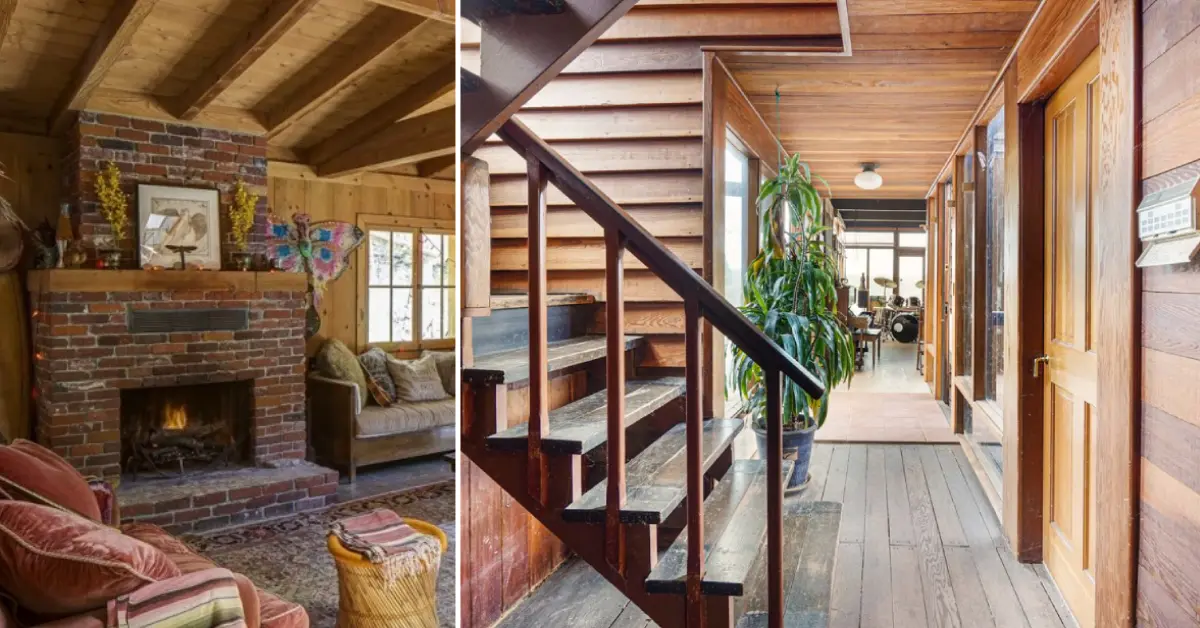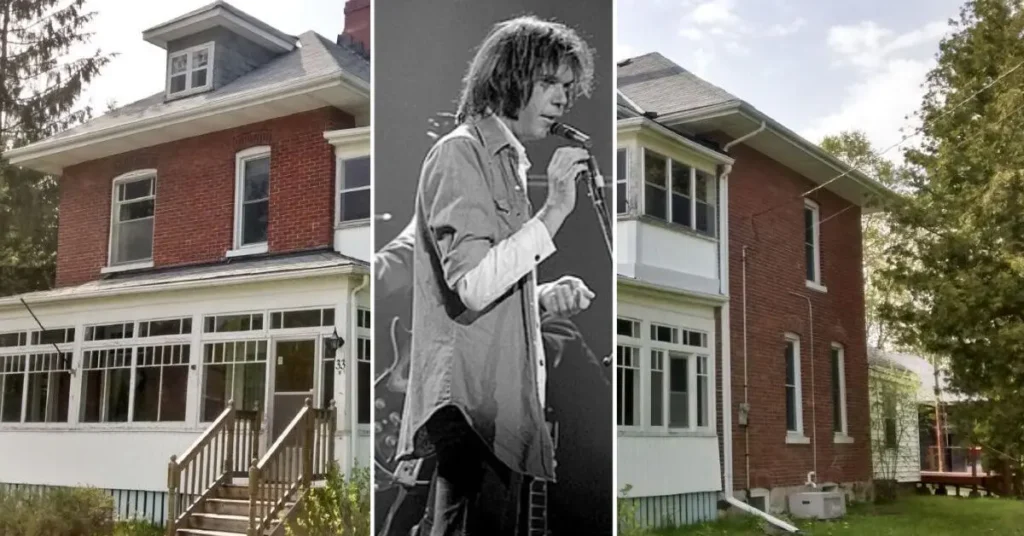Neil Young bought Broken Arrow Ranch for $350,000 in 1970 and turned it into a legendary creative retreat. Over the decades, the ranch became the backdrop for some of his most iconic songs and moments in rock history.
The Story Behind Neil Young House
Neil Young’s ranch spans 140 acres in the rural hills between La Honda and Half Moon Bay, near Redwood City, California. The property takes its name from Young’s Buffalo Springfield song “Broken Arrow,” released in 1967. Young was drawn to the land’s quiet and natural beauty—qualities that shaped both his music and how he built the property.
The ranch became Young’s primary residence and creative sanctuary throughout the 1970s and beyond. Unlike many celebrity homes that prioritize glamour, Young’s property reflects his commitment to authenticity and connection with the land.
History and Location
At 24, fresh off success with Crosby, Stills, Nash & Young, Young bought the ranch at the end of Bear Gulch Road. The timing proved perfect—he needed a retreat from the intensity of fame and a place to explore his evolving musical vision. The previous owners had used the land primarily for cattle ranching, leaving behind weathered barns and outbuildings that Young would later transform.
The location offers complete privacy while remaining within driving distance of San Francisco’s recording studios and music scene. The remote roads keep visitors away—ideal for an artist who values quiet and space. This geographic isolation has protected the ranch from development pressures that have transformed much of the surrounding Bay Area.
One of the most famous stories from the early days involves Louis Avila, the ranch’s caretaker. Young grew close to Avila, who had worked the land for years before Young’s arrival. Their relationship inspired Young to write “Old Man,” one of his most beloved songs. The lyric “Old man, look at my life, I’m a lot like you were” captures the deep respect Young felt for Avila and the shared connection to the land.
Architecture and Design
The main house reflects simple California ranch style—clean lines, natural materials, and no excess. Built in the early 1900s, the structure features wide-plank wood floors, exposed beams, and large windows that frame views of the surrounding hills. Young has carefully preserved the home’s original character while making necessary updates for modern living.
The barn stands out most, a rustic structure turned world-class studio that Young converted into a world-class recording studio. Working with Tim Mulligan, his longtime engineer, Young approached the barn renovation with unusual goals. Instead of soundproofing everything, they kept the barn’s natural acoustics, letting its warm, live sound shape the music. The massive wooden beams and high ceilings create a warm, live sound that has become integral to Young’s recordings.
Materials throughout the property reflect Young’s environmental consciousness. Reclaimed wood appears in new construction, while original stonework has been carefully maintained. The buildings seem to grow from the landscape rather than impose upon it, a design philosophy that extends to every structure on the property.
Key Features and Spaces
The main house anchors daily life at the ranch, with rooms that flow naturally and vintage pieces that feel lived-in, with vintage furniture and personal memorabilia creating a lived-in atmosphere. Young’s guitar collection occupies various corners, ready for spontaneous playing. The kitchen, updated in the 1990s, maintains its farmhouse character with a large wooden table where Young has written many songs.
The barn studio stands as the property’s creative center. The main recording space can accommodate a full band, with the high ceiling providing natural reverb. The control room is packed with vintage analog gear—Young’s preferred setup for warm, unpolished sound. The barn’s original hay loft now houses additional isolation booths and storage for Young’s vast tape archive.
Beyond these primary structures, the property includes guest houses where visiting musicians stay during recording sessions. The stables, though no longer housing horses, provide storage for Young’s collection of vintage cars and model trains. A private lake offers a peaceful retreat, while miles of trails wind through the property’s forests and meadows.
Renovations and Changes Over Time
The ranch has evolved continuously since Young’s purchase, with each change reflecting his artistic journey. The barn studio transformation happened gradually through the 1970s and 1980s, as Young and Mulligan experimented with different configurations. They discovered that minimal treatment preserved the space’s unique acoustic properties, leading to the distinctive sound heard on albums like “Harvest” and “Tonight’s the Night.”
A major renovation occurred in the early 1990s when Young upgraded the studio’s electrical systems and added climate control without compromising the barn’s character. The project required careful engineering to hide modern infrastructure within the historic structure. During this period, Young also built additional outbuildings for equipment storage and workshop space.
Young lost his Malibu home in the 2018 Woolsey Fire, but Broken Arrow Ranch was untouched. The experience prompted Young to implement extensive fire prevention measures at the ranch, including defensible space clearing and upgraded water systems. Those steps proved crucial, especially as wildfires have worsened across California.

Most recently, Young undertook renovations for the 2020 recording sessions that produced the album “Barn.” The project involved restoring some original barn features while upgrading the recording equipment. Documentary footage from these sessions shows the care taken to preserve the space’s authentic character while meeting modern recording needs.
Stories and Significance
Broken Arrow Ranch has hosted countless memorable moments in rock history. Bob Dylan, Joni Mitchell, and members of Pearl Jam have all recorded within the barn’s walls. The property’s relaxed atmosphere encourages creativity—musicians often mention feeling freed from typical studio pressures when working there.
The ranch played a crucial role during Young’s experimental phase in the 1980s. Albums like “Trans” and “Everybody’s Rockin'” might have seemed like departures from his folk-rock roots, but they were all conceived and developed at Broken Arrow. The property’s isolation allowed Young to explore new sounds without outside influence or immediate judgment.
Young’s commitment to analog recording technology has made the barn studio increasingly unique in the digital age. Artists looking for old-school sound often seek out the barn, drawn by its gear and natural acoustics. The combination of historic architecture and carefully maintained analog gear creates possibilities unavailable in modern studios.
Visiting and Virtual Tours

While Broken Arrow Ranch remains private property closed to public visits, Young has offered rare peeks inside. The 2020 film “Barn” gives the most in-depth look, showing both the music-making and the land itself, with cameras capturing both the recording process and the surrounding landscape. Several music videos filmed on location provide additional views of the ranch’s buildings and natural features.
Online resources include photographs from recording sessions and aerial views that show the property’s layout. Young’s official archives occasionally release historic images from the ranch’s early days, showing its transformation from a working cattle ranch to a musical landmark. These glimpses satisfy curiosity while maintaining the privacy essential to the property’s continued use as a creative retreat.
Fans can take in the same hills and forests that inspired Young, without crossing onto private land. The surrounding hills and coastal mountains offer public hiking trails with views similar to those from Broken Arrow Ranch. The nearby town of La Honda maintains the rural character that first attracted Young to the region.
Conclusion
Broken Arrow Ranch isn’t just Young’s home—it’s a reflection of how he lives and creates, grounded in the land. The property’s influence extends through decades of recordings that capture not just songs but the essence of the place where they were born. The barn’s wooden walls have absorbed thousands of hours of music, becoming an instrument in their own right.
Young’s stewardship of the ranch demonstrates how celebrity properties can enhance rather than diminish their natural settings. By preserving historic structures and maintaining the land’s rural character, he has created a model for environmentally conscious property ownership. The ranch continues to evolve while honoring its past, much like Young’s ever-changing musical journey.
As Young continues recording at Broken Arrow Ranch well into his 70s, the property remains central to his creative process. New artists continue to record in the barn, keeping its influence alive in today’s music. The ranch proves that the right environment can nurture artistic vision across decades, creating a legacy measured not just in albums but in the ongoing vitality of a living, working creative space.


